Monday, July 30, 2012
1976-77 Minnesota Fighting Saints Louie Levasseur Jersey
July by the Numbers makes a pilgrimage to the State of Hockey for jersey #30.
The original Minnesota Fighting Saints were charter members of the World Hockey Association for the 1972-73 season, wearing jerseys with a large "S" logo at first in white, blue and even occasionally yellow. Midway through their first season a new set of jerseys appeared with the "Little Saint" logo, but only in the home white and road blue colors.
Keith "Huffer" Christiansen modeling the Fighting Saints original "S" logo sweater
The club, led by captain Ted Hampson, finished mid-pack record-wise, but found themselves in the tougher Western Conference, where they were forced to play a one game tiebreaker against the Alberta Oilers to advance to the playoffs, despite both clubs having better records than Philadelphia and Ottawa who qualified in the East.
The inaugural 1972-73 Minnesota Fighting Saints team
The team also finished mid-pack in attendance, drawing an average of 5,855 while competing with the crosstown Minnesota North Stars, who had a five year head start in the NHL, but who were at the peak of their popularity attendance-wise, attracting sellout crowds of over 15,200 fans for the second of three consecutive seasons.
The Fighting Saints added to their roster for their second year of 1973-74, signing goaltender John Garrett to share the duties in goal with former 1972 silver medal winning US Olympian Mike Curran, but the real attention getter was the signing of forward Mike "Shakey" Walton away from the Boston Bruins, who would electrify the fans with a 57 goal, 117 point season to win the WHA scoring crown.
Walton left opponents in his wake in 1973-74.
As always with any Fighting Saints photos, be sure to note the clear
dasher boards in St. Paul, which were unique to rinks in all of North America
Additionally, Wayne Connelly (95 points, 4th overall) and George Morrison also had 40 goal seasons to get the fans in St. Paul on their feet, while the fighting ability of Gord Gallant and John Arbour (first and third in WHA penalty minutes) kept them standing.
The 1973-74 Minnesota Fighting Saints
Also on the roster of note was fourth leading scorer Murray Heatley (26 goals and 58 points), father of current NHLer Dany Heatley, who now plays for the NHL's Minnesota Wild in St. Paul's Xcel Energy Center, which is built on the old location of the Fighting Saints arena, the St. Paul Civic Center.
The Fighting Saints completed the season with the second best record in the league and defeated the rechristened Edmonton Oilers in Round 1 of the playoffs, but were defeated by the mighty Houston Aeros in a six game war in Round 2.
The Aeros Ted Taylor and the Fighting Saints Gord Gallant fought
as the clubs engaged in a vicious playoff battle
Meanwhile, ten miles down the road, the North Stars sank from a 37-30-11 record for 85 points down to a 23-38-17 record, worth just 63 points, which caused them to miss the NHL playoffs while the Saints were selling over 17,000 seats for their battle with the Aeros.
The North Stars did themselves no favors in 1974-75 by sinking even further to 23 wins and 51 points, missing out on the playoffs again, a season which saw their attendance take a noticeable drop to 13,587.
Meanwhile, in St. Paul, Garrett alone posted 30 wins, seven more than the North Stars, while Curran added 11 more and even 40-year-old veteran Jack McCartan, a 1960 US Olympic gold medal winner, chipped in with a win as the Fighting Saints finished sixth in the league with 87 points as their average attendance grew to 8,410, a healthy increase of 1,800 per game.
Walton again led the team with 48 goals and 93 points, compared to Dennis Hextall's team leading 74 for the North Stars. Gallant again led the WHA with 203 penalty minutes and Ron Busniuk 176 were tied for third as the Fighting Saints games were never a dull affair. Their final home game of the season against Phoenix saw a crowd of 17,312 set not only a team record, but the then record for the state of Minnesota (which gave the Fighting Saints bragging rights over the North Stars) and the all-time WHA record which was never broken.
Shakey Walton again led the Fighting Saints in scoring in 1974-75
In the playoffs, the Fighting Saints fought off the New England Whalers in six games, before being eliminated in six games by the Quebec Nordiques.
The 1974-75 Minnesota Fighting Saints
The 1975-76 season would prove to be a pivotal one for the two clubs, as the North Stars sank still lower, a 53 loss 47 point season, led by Tim Young with just 51 points and Bill Goldsworthy's 24 goals left them ripe for the picking.
The Fighting Saints reloaded their roster by adding NHL veterans Dave Keon and John McKenzie to their lineup, which was again led by Walton in scoring. Minnesota natives Henry Boucha and Paul Holmgren should have added to the gate, along with the popularity of fighter Jack Carlson, but with attendance stagnant at 8,396 (compared to the dismal North Stars 9,655), the Fighting Saints were in financial difficulties, which included an episode where they players were paid in cash out of a paper bag at the airport to convince them to get on a plane for a road trip!
The true life inspiration for Slap Shot's Hanson Brothers,
Jack Carlson willingly takes on all comers
Shortly after that episode, the club packed it in after only 59 games of the schedule had been completed with the team at 30-25-4, on pace for 86 points and a sure playoff spot.
For the 1976-77 season, changes were afoot, as the NHL's California Golden Seals moved to Cleveland and became the Barons, setting up shop at the Richfield Coliseum. Meanwhile, the WHA's Cleveland Crusaders, fearing Cleveland was not large enough for two professional clubs, were looking for a new home.
When their proposed sale, which would have moved the team to Florida, fell through, the franchise eventually moved to St. Paul, where it became the second incarnation of the Minnesota Fighting Saints, this time with the New Fighting Saints wearing red and yellow rather than the blue and yellow of the original Fighting Saints, but oddly still competing directly with an established NHL club.
Many of the previous Fighting Saints players were brought in to try to recapture the fans of the original incarnation of the team, including Keon, Mike Antonovich, McKenzie, Arbour, Gallant (who had been sent packing by the original club after a late night, alcohol-fuled fight with then Fighting Saints coach Harry Neale!), Carlson, Bill Butters and Curran.
John McKenzie in the scarlet and gold of the New Fighting Saints
The public never embraced the new team, despite the familiar faces, having already had one team ripped from their grasp in midseason leaving a bad taste in the mouths of many. With attendance averaging just 6,211 and the team playing just barely over .500 at 19-18-5, team owner Nick Mileti's attempts to sell the club to local owners proved unsuccessful and the team folded after just 42 games of the 1976-77 season, bringing an end to the franchise on January 20, 1977, ending the WHA's time in Minnesota for good.
The final Fighting Saints club, the red clad 1976-77 squad, found time for a team photo before folding after only half a season
Of the nine times the WHA went head to head with the NHL - Boston (1 1/2 seasons), Philadelphia (1), New York (1 1/4), Los Angeles (2), Minnesota (4 1/4), Chicago (3), Toronto (3), Vancouver (2) and Detroit (just 3/4) - the NHL prevailed easily each time with arguably the Fighting Saints giving it the best effort in terms of durability, competitiveness and attendance. The WHA quickly learned taking on the established league was a losing proposition and abandoned placing teams in NHL served markets for good with the folding of the New Fighting Saints.
For the remainder of their days, spent trying to merge with the NHL, the WHA served smaller, less traditional markets such as Cincinnati, Indianapolis, Birmingham, San Diego, Houston and Phoenix in addition to their successful teams in smaller Canadian markets like Winnipeg, Edmonton and Quebec, although not all of the Canadian ones were successful, as teams failed miserably in Ottawa and Calgary even without competition from the NHL.
Meanwhile, the North Stars attendance sank even further to an average of 9,083 despite the loss of competition from the original blue-clad Fighting Saints, despite rising from 47 points to 64 in 1976-77. Their improvement proved to be a mirage, as they next sank to a team record low to last in the NHL with just 45 points in 1977-78 when they averaged only 8,666 per game, 56% of their average number of fans in 1971-72, the year before the Fighting Saints arrived just down the road.
Ironically, the North Stars would not rebound until a merger with the Cleveland Barons, the team that displaced the WHA's Crusaders, who became the red-clad Fighting Saints to once again compete with the North Stars, happened in time for the 1978-79 season and re-energized the struggling, battle-weary North Stars, who suffered greatly during the WHA era like no other NHL club.
Today's featured jersey is a 1976-77 Minnesota Fighting Saints Louie Levasseur jersey from the second incarnation of the Fighting Saints, who were the transplanted Cleveland Crusaders. The new Fighting Saints simply kept everything intact about the original Fighting Saints jerseys with the Little Saint logo, introduced midway through their first season, except for switching the original blue color for red, which did not do much for the jerseys, as the greater contrast between the blue and yellow made for a much more effective look than the lower contrast red and yellow.
It proved to be a non-issue when the second incarnation of the Fighting Saints lasted barely one half of a season when the operation had more problems with their finances than how they played or looked while doing it.
In our extensive video section begins with a highlight film of the Fighting Saints first season of 1972-73. Notice the gold alternate jerseys with the original "S" logo, none of which are known to have survived, as the logos were removed and the sweaters were handed down to a local high school who shared the same colors.
Another thing to be aware of again are the unique clear boards used in the St. Paul Civic Center, which allowed fans a view of the puck at all times, particularly those fans in the first several rows of seats, which were set back from the boards by a fair distance due to the round layout of the Civic Center.
Next up, coach Neale interviews a few of the Fighting Saints roster prior to Walton's record setting season. Goaltender Garrett's suit and bow tie along are worth your time as he does some early time in front of the TV cameras prior to his current broadcasting career. Walton would go on to exceed the prediction of 50 goals.
Here is a more recently produced video on the Fighting Saints, during which Walton himself verifies the story about leaving the rink in full gear and heading to the bar, as well as the arrival of the real life Carlson Brothers, who inspired the Hanson Brothers from the movie Slap Shot.
Next is the retelling of the tale when Gallant beat up his own coach!
Finally, the retelling of "The Brawl at the Mall", the infamous fight between the New England Whalers (whose arena, the Hartford Civic Center was connected to a shopping mall) and the Fighting Saints, who were loaded with tough guys who were only too happy to live up to the team's name "Fighting"!
If you are interested in some rare Minnesota Fighting Saints jerseys, our friends at VintageMinnesotaHockey.com have a series of excellent reproductions, more accurate than anything found anywhere else online.
Labels:
Minnesota Fighting Saints
Subscribe to:
Post Comments (Atom)

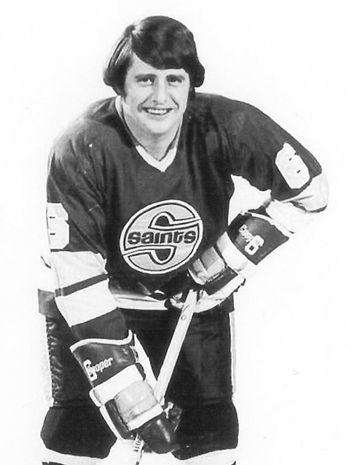
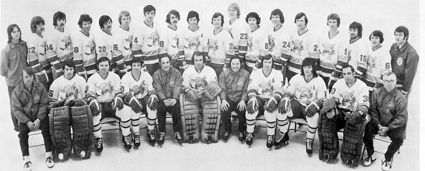
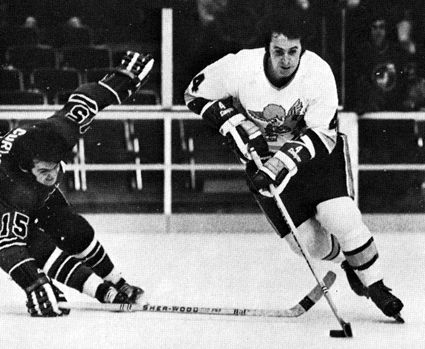

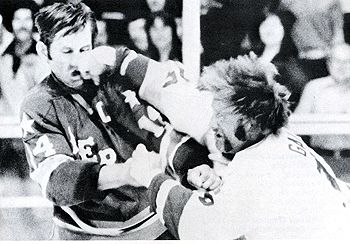
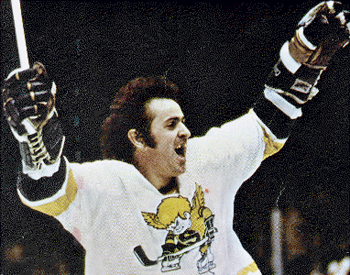
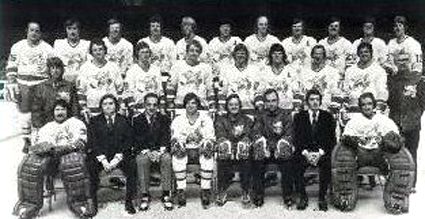
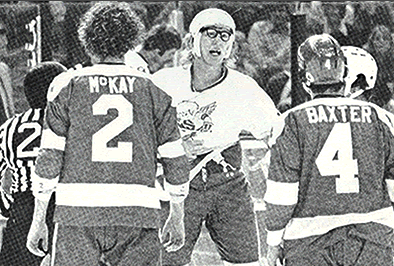
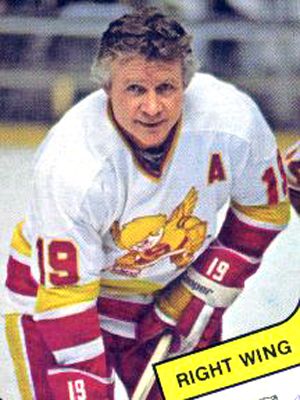
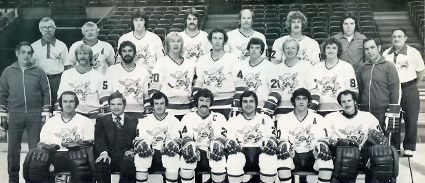
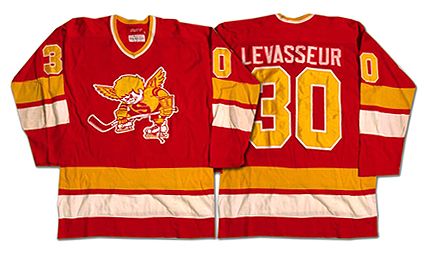










I once owned this Levasseur jersey many years ago.
ReplyDelete